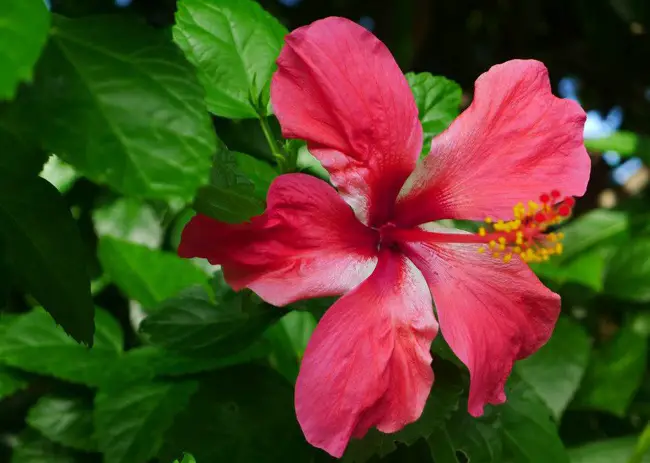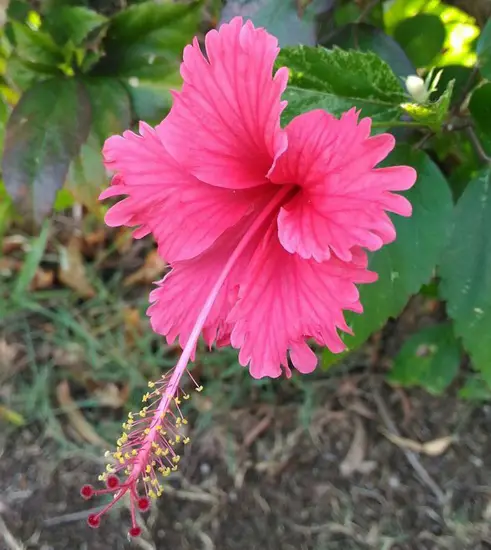I came across two hibiscus plants with gorgeous flowers in my garden yesterday. One was no more than 3 feet tall but already had blooming red flowers. The plant showed signs of robust health and vigor. The larger hibiscus stood erect. My guess would be over 5 1/2 feet high.
Dozens of large, red flowers were opened wide and reaching for the sun. Truly a lovely flowering plant to have in your garden or throughout your landscape. Real attention grabbers.
Even though there are many flowing plants out there to choose from, the hibiscus has got to be one of my favorites. One of its attractive features is that the leaves of this hibiscus plant change colors. If you have multiple plants grouped, they tend to look like different plants altogether. I’ve heard that the color change occurs due to the age of the plant. I’m not sure of that, though.
Over the years, I have bought many hibiscuses from a local plant nursery. They usually give me a few flowers the first year they get planted in the ground. After two years of healthy growth, the flowers bloom in large numbers.
To be honest with you, I put much effort into growing and caring for my hibiscus plants. They receive about four hours of direct sunlight and approximately two hours of indirect sun. They seem to like a fair amount of sunlight.
I had other hibiscus plants growing primarily in the shade, and they did not do well. They grew, but not like ones that received more direct sunlight. I hand water them maybe once a week and rely on Mother Nature to do the rest.
I fertilize the plants twice a year, once in spring and again in fall. This hibiscus plant has beautiful foliage and flowers any gardener would enjoy. The flowers come in many different colors and shades, which I’m sure you will name your favorite.
The Hibiscus Plant is a Popular Plant
Though the traditional hibiscus plant has been popular for many years, lately, one trend has been growing the tropical type. This can be easily achieved, even by those who live in less temperate climates. All it takes are a few simple precautions to protect the tropical plant during the winter.
The first step in protecting your plant is to determine whether you have a tropical plant or a hardy, perennial plant. When you shop for your plants, the store will often sell any hibiscus under the same umbrella.
Unfortunately, that means if you leave your tropical variety out in the cold weather, it will die. One good frost is all it takes to destroy it.
To determine which type of plant you have, check the leaves. Are they glossy and deep green? Are the shades of the flowers red, orange, pink, or yellow? Then the chances are good that it is the tropical type.
On the other hand, if it has dull green leaves and only red or pink flowers, then it is most likely a traditional, hardy type.
Upon discovering that you are the proud owner of a tropical variety, you will need to bring the plant inside before the temperature drops below 40 degrees. You will need to place them under plenty of artificial lighting that utilizes fluorescent lights by bringing them in.
At all times, the temperatures should be between 55 and 70. The lower temperatures are actually more ideal, as they will help lessen the chances of insect infestations later in the year.
When growing this plant, every owner should find out which type they have. Determining this information will determine if you can leave your hardy perennial plant outdoors all winter or if you will need to bring your tropical hibiscus plant indoors for the winter.
The hibiscus plant casts a dramatic effect on the landscape
The hibiscus plant is one of the best-known shrubs because it casts such a dramatic effect over the landscape. Unfortunately, however, it is also one of the most susceptible plants to various insect infestations. The most common of these insect attackers are aphids, ants, spider mites, mealy bugs, whitefly, and scale.
Read also: How To Get Rid Of Bugs On Hibiscus Plants
Aphids are frequently too small to see without a microscope, but the tiny insects operate by sucking on the shrub’s leaves. They, fortunately, are easy to control.
A simple hose set on the high or careful application of liquid soap should do the trick for getting rid of small aphid populations. For larger populations, Orthene and soap will do the same job.
If you have aphids, chances are pretty good ants also are bothering you. Ants rely on aphids because of the sweet substance the aphids produce. The best way to get rid of the ants is to get rid of the aphids.
Along with ants and aphids, major pests to the hibiscus are spider mites. These are usually so small that you require a magnifying glass to see them, and occasionally, you’ll need a magnifying glass to see their webs as well, though sometimes the webs will be big enough to see without one.
If you begin to see pale, yellowish spots on the top of leaves with bumps on the bottom, the chances are good that you have spider mites. Through the use of fine oils or matricides, you can eliminate spider mites.
Mealybugs, unlike spider mites, are typically large enough to see. They are small and soft-bodied and can be easily eliminated using an alcohol spray.
Whitefly can cause the death of a hibiscus plant. To be rid of them, you’ll need Orthene and Murphy’s Oil soap. Coat beneath leaves up to four times to get rid of whitefly.
Scales are an additional sucking insect that typically starts at the base of a trunk. Orthene and fine oil or a weak bleach solution will work well in ridding these insects. Likewise, so will a light spray of Pam or WD-40.
Though they are gorgeous ornaments to have in our homes, the hibiscus plant can fall prey to many pests. You can easily take care of these insect invaders as long as they are caught early.
How To Make Your Hibiscus Plants Healthier and Disease-resistant
The hibiscus is an attractive plant with big, beautifully colored flowers. They need small care and can be grown inside or outside your home.
If you provide proper care to this plant, you’ll be rewarded will brightly colored flowers.
Climate needs
The hibiscus plant is native to tropical regions of the world. With that being said, it must be kept warm if you ever hope to have plentiful blooms.
This hibiscus needs warm conditions to thrive and bloom. The best temperature range for this plant is between 60 and 90 degrees Fahrenheit.
Temperatures that drop below sixty degrees can cause the growth of the hibiscus to slow or stop. Anything below freezing will likely hurt the plant or kill it off altogether.
As we said earlier, the hibiscus plant needs warm temperatures to thrive. However, when the temperature is pushing above 90 degrees, the flowers may begin to fall off and shed some leaves.
More Hibiscus Tips: This is not a real problem just as long as you keep the plant properly hydrated.
Watering is an important part of hibiscus plant care
Proper watering play is an important part of any plant’s success. The hibiscus is no different. When temperatures are running in the 90-degree and above range, provide the plant with generous amounts of water.
Hibiscus leaves and blooms are full of moisture. During the hot days of summer, a steady supply of water is recommended. If you see the leaves of the hibiscus plant begin to droop, that is a reliable sign it needs watering.
During the fall and winter, when growth slows, back off on watering. Giving a plant too much water when the growth cycle slows can lead to root disease.
During the cooler seasons, water the hibiscus only when the soil is no longer moist. If you grow the hibiscus in a pot, make sure it has good drainage at the bottom.
What you don’t want are the roots to remain waterlogged for extended periods. Excessive moisture is where many fungal diseases develop. Sandy, well-drained soil can prevent this from occurring.
Feeding your hibiscus plant
Plant food is needed to keep your plants healthy. Use a good quality fertilizer with a high potassium content. The hibiscus plant prefers frequent smaller feedings instead of once-a-year fertilizing. The best advice is always to follow the directions on the packaging.
The hibiscus is well-known for its heavy blooms. To preserve their steady growth and development, regular fertilization is recommended. There are fertilizers made just for hibiscus plants.
Please keep in mind fertilizer should not be spread right up against the plant stem because it can cause chemical burns. As with any fertilizer or insect treatment, follow the label instruction carefully. Don’t like using synthetic fertilizer? Mix in aged compost, worm castings, and other organic matter.
Protect your hibiscus plant against garden pests
An important part of hibiscus plant care includes keeping garden pests off your plants. Here are a couple of choices. One is to spray them with pesticides and other chemicals. Although this method works, I don’t recommend it unless necessary.
Store-bought sprays are dangerous to humans, pets, and the environment. Your second choice is to attract beneficial insects into your garden. Ladybugs, lacewings, and praying mantis will help control any garden pests from harming your hibiscus plant.
If you give these hibiscus plant care tips a chance, they’ll reward you will large, beautiful flowers in orange, red, pink, white, and other bright colors. Hibiscus care is not difficult and well worth your efforts.
If you are lucky enough to live in a warm part of the country, the hibiscus plant makes a great addition to your garden, landscape, or home.
Its blooms are striking, frequent, and come in a pleasing array of colors and sizes. If you understand basic hibiscus plant care, beautiful foliage and flowers can be yours year-round. Let us get to it.
Sunlight needs
The hibiscus plant thrives in sunny locations but also can grow in the shade. Ideally, choose a location that gets two to four hours of direct sunlight.
Sunlight is needed to stimulate healthy blooms every family member and neighbor will adore. If grown indoors, choose the brightest location available.



When I was working for a high end landscaping company as a gardener, it upset me how many plants were just thrown away as the clients’ tastes, seasons or plant health changed.
I would give them away to workers or take them home and nurse them back. One of these is a pink tropical hibiscus that was getting tossed because it hadn’t been watered by a client who refused to install irrigation of any kind.
I’ve had it for 5 years now with no problems until last July. I brought home 2 ivies from a chain store. I didn’t take the time to look as well as I thought I had…major mistake.
Both poor things were dead in a week and a half from spider mites. When I removed all of the dead leaves, I saw how heavily they’d been pruned, probably trying to fix the problem in the store without being able to spend the time. My hibiscus was the only plant who caught them but now I’m having a hard time getting rid of them.
I tried spraying off the plant every day when it was warm outside. Then I tried nicotine tea (killed the flies that got it outside) but hardly put a dent in the spiders. Then I came here from Google looking for another natural way to stop them.
I have to look up Orthene but the Murphy’s passion has been passed down through my Dad’s side so I have that. I’ll give this a try and really hope it works.